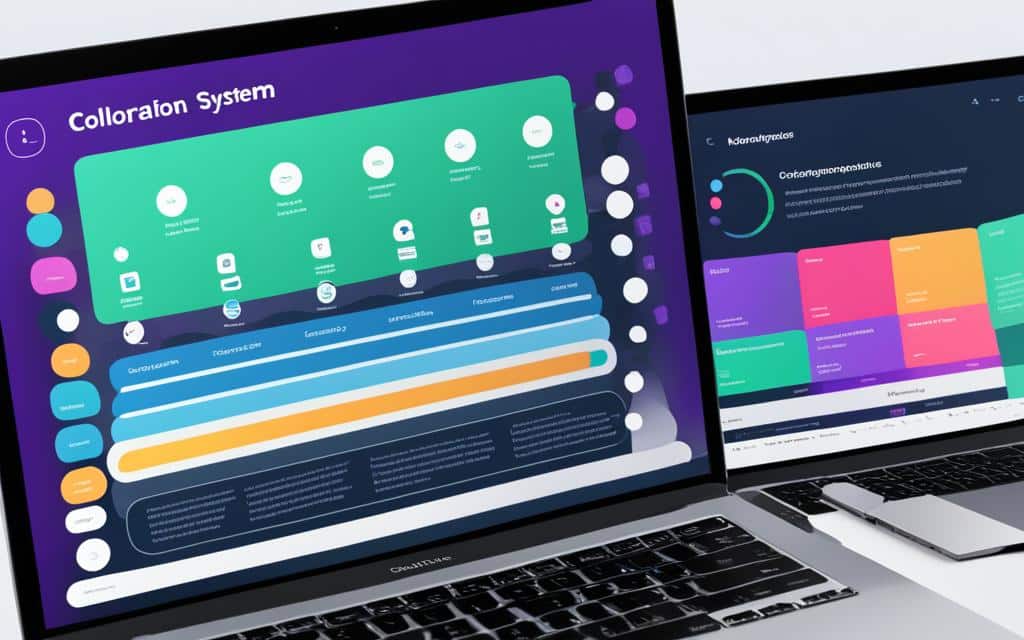Table of Contents
In the dynamic landscape of digital product development, the need for harmony and collaboration between designers and developers cannot be overstated. The solution to this problem lies in the implementation of design systems. Design systems serve as the universal language that bridges the gap between designers and developers. They encompass style guides, pattern libraries, UI kits, and code components, promoting consistency, reducing rework, and expediting the design to development workflow. Design systems foster collaboration by establishing a shared understanding and vocabulary, ensuring synergy and efficient teamwork. They also offer several benefits such as consistency, faster iterations, reduced design debt, and improved accessibility.
Components of a Design System
The heart of a design system lies in its component library, which comprises a collection of reusable design and code components. These components, including buttons, forms, menus, and more, form the building blocks of a consistent and cohesive user interface (UI). By leveraging a component library, designers and developers can maintain visual and functional consistency across different screens and platforms, streamlining the design to development workflow.
With a standardized set of components, designers can focus on crafting delightful user experiences without reinventing the wheel for every project. Developers, on the other hand, can efficiently implement these pre-designed components, reducing duplicate work and speeding up the development process. This collaborative approach fosters better teamwork and ensures a higher quality end product.
Benefits of Design System Components:
- Promotes consistency: Designers and developers can create harmonious and consistent designs by leveraging a well-defined set of pre-designed components.
- Streamlines workflow: By reusing code and design elements, developers can save time and effort, leading to faster iterations and more efficient development cycles.
- Reduces design debt: With a component library, designers can avoid creating redundant designs, minimizing design debt and allowing for easier updates and maintenance.
- Improves accessibility: Design system components can be built with accessibility standards in mind, ensuring a more inclusive experience for all users.
Design system components offer a multitude of advantages in terms of efficiency, consistency, and accessibility. By implementing a robust component library, designers and developers can elevate their collaboration and deliver exceptional digital products.
| Benefits of Design System Components |
|---|
| Promotes consistency |
| Streamlines workflow |
| Reduces design debt |
| Improves accessibility |
Implementing a Design System: A Step-by-step Approach
Implementing a design system is a complex and ongoing process that requires careful planning and execution. To ensure a successful implementation, the following step-by-step approach is recommended:
- Audit and Identify
- Define Design Principles
- Develop a Component Library
- Establish Documentation Practices
- Engage Stakeholders
- Continuously Iterate and Update
The first step is to conduct a thorough audit of the current design components. This involves evaluating the existing design elements and identifying areas that need improvement or standardization. By identifying these gaps, you can establish a solid foundation for the design system implementation.
Once you have audited the design components, it’s time to define clear design principles. These principles provide a guiding framework for the creation of new components. By adhering to these principles, designers can ensure consistency and coherence throughout the design system.
A critical aspect of implementing a design system is creating a comprehensive component library. This library serves as a repository of reusable design and code components, ensuring consistency in design and development. By establishing a component library, designers and developers can save time and effort by reusing existing components rather than creating them from scratch.
Clear and accessible documentation is essential for a successful design system implementation. Designers and developers must create guidelines and documentation that outline the design principles, component usage, and code references. This documentation serves as a central resource for all stakeholders involved in the design and development process.
In order to gather valuable feedback and ensure alignment, it’s crucial to involve all stakeholders throughout the implementation process. This includes designers, developers, product managers, and any other relevant team members. Regular meetings, workshops, and feedback sessions can help identify possible improvements and address any concerns.
A design system is never complete; it evolves alongside the product it serves. It’s essential to continuously iterate and update the design system as new design requirements and technological advancements arise. Regularly reviewing and improving the components, guidelines, and documentation ensures that the design system remains relevant and effective.
By following this step-by-step approach, you can successfully implement a design system that promotes consistency, improves collaboration between designers and developers, and streamlines the design to development workflow.
Inclusive Design Systems
A critical aspect of design systems is the promotion of inclusive and accessible design. By setting accessibility standards in the design system, designers and developers can ensure that the product is usable by all, including those with disabilities. This widens the user base and promotes social inclusivity in digital products.
Design systems should consider factors such as color contrast, keyboard navigation, screen reader compatibility, and other accessibility best practices to make the product accessible to everyone.
Creating an inclusive design system means incorporating accessible design principles from the outset. This eliminates the need for retrofitting accessibility features and ensures that all users can engage with the product from day one. By adhering to accessibility standards, designers and developers can make a positive impact on people’s lives and improve the overall user experience.
“Accessible design is good design. It benefits people who don’t have disabilities as well as people who do. An accessible Web site is one that not only looks good, but works well, too.” – Joe Clark
Designing with inclusivity and accessibility in mind results in a more user-centric approach that caters to the diverse needs of individuals. It includes considerations such as:
- Providing alternative text descriptions for images to assist visually impaired users.
- Ensuring a color palette that meets contrast requirements for people with color blindness or low vision.
- Implementing keyboard navigation options for users who have difficulty using a mouse.
- Using appropriate heading structures and semantic markup to facilitate screen reader navigation.
By integrating inclusive design practices into the design system, designers and developers can create products that are accessible, intuitive, and enjoyable for everyone, regardless of their abilities.
Design systems that prioritize inclusive design not only comply with accessibility standards but also foster a more inclusive and equitable digital environment. By valuing diversity and addressing the needs of every user, inclusive design systems can achieve universal usability and provide equal access to information and services.
Design Systems in Action
Several high-profile companies have successfully implemented design systems. Google‘s Material Design, IBM’s Carbon Design System, and Airbnb’s Design Language System are excellent examples. These companies have embraced design systems to bridge the gap between designers and developers and ensure product uniformity. By implementing design systems, these companies have accelerated the design and development process, resulting in efficient collaboration and high-quality products.
Google’s Material Design is a comprehensive design system that provides guidelines and resources for creating visually appealing and user-friendly interfaces. It encompasses a wide range of components, such as buttons, cards, and navigation elements, that are designed to be consistent across different platforms.
IBM’s Carbon Design System focuses on scalability and flexibility, catering to the needs of enterprise-level applications. It provides an extensive library of reusable components, ensuring consistency and simplifying the design process for IBM’s vast range of products.
Airbnb’s Design Language System is designed to provide a seamless experience for both users and developers. By incorporating a set of design principles and components, Airbnb ensures that its product maintains a cohesive look and feel, while also allowing for customization to meet specific user needs.
“Design systems are crucial for companies seeking to streamline their design and development processes. By establishing a unified language and set of components, these systems enable designers and developers to work more efficiently and collaboratively, resulting in higher quality products.”
Implementing design systems has allowed these companies to achieve consistent branding and user experiences across their platforms. It has also facilitated faster iterations and reduced design debt, enabling them to adapt and evolve quickly in response to changing user needs.
Take a look at the visual representations below to see how these design systems have contributed to the success of these companies:
| Company | Design System | Key Features | |
|---|---|---|---|
| Material Design | A visually stunning design language that emphasizes the use of bold colors, responsive layouts, and subtle animations. | ||
| IBM | Carbon Design System | A modular and scalable system that enables designers and developers to create consistent and flexible enterprise-level applications. | |
| Airbnb | Design Language System | A cohesive set of design principles and components that ensure a seamless user experience across different platforms. |
The Future of Design Systems
Design systems are shaping the future of digital product development. Offering a multitude of benefits, they empower an iterative, collaborative, and efficient workflow. By providing a standardized language and promoting clear communication, design systems cater to the needs of both designers and developers. As technology continues to advance, design systems will play a vital role in creating consistent and user-friendly digital experiences.
One of the key advantages of design systems is their ability to facilitate an iterative workflow. Designers and developers can continuously iterate and improve upon existing components within the system, ensuring that the end product is constantly evolving and meeting user needs. This iterative approach allows for flexibility and agility in the design process, leading to better outcomes and a more satisfying user experience.
Collaboration is another crucial aspect of design systems. By establishing a shared language and set of guidelines, designers and developers can collaborate seamlessly. This collaborative workflow streamlines the design to development process, reducing misunderstandings and accelerating the overall timeline. It fosters a sense of teamwork and cohesion, where designers and developers can work together towards a common goal.
“Design systems have revolutionized the way we work, enabling designers and developers to speak the same language and work in a synchronized manner. They promote collaboration and foster an environment of efficiency and creativity.”
As the digital landscape continues to evolve, design systems will adapt and flourish. They will remain at the forefront of digital product development, driving innovation and efficiency. Design systems will evolve with emerging technologies and trends, accommodating new design principles and expanding their capabilities. They will continue to ensure consistency, accessibility, and usability in the ever-changing digital world.
Benefits of the Future Design Systems
- Promote collaboration and synergy between designers and developers.
- Enable an iterative workflow for continuous improvement and adaptation.
- Ensure consistency and uniformity across different platforms and screens.
- Streamline the design to development process for faster turnaround times.
- Enhance user experience through improved accessibility and usability.
Design systems are a powerful tool that will shape the future of digital product development. Their ability to enable an iterative and collaborative workflow ensures that designers and developers can work together efficiently. As technology advances, design systems will continue to adapt and evolve, promoting consistency and delivering user-friendly experiences.
| Key Attributes | Future Impact |
|---|---|
| Consistency | Ensures a cohesive and unified user experience across platforms. |
| Efficiency | Accelerates design and development processes, reducing time and effort. |
| Usability | Delivers user-friendly products with enhanced accessibility and ease of use. |
| Innovation | Adapts to emerging technologies and trends, driving creative solutions. |
Recommended Literature
To delve deeper into the world of design systems, there are several recommended books that provide valuable insights and practical guidance. These books offer a wealth of knowledge from industry experts, allowing designers and developers to enhance their understanding and implementation of design systems.
“Design Systems: A Practical Guide to Creating Design Languages for Digital Products” by Alla Kholmatova
In this book, Alla Kholmatova explores the practical aspects of creating effective design systems. With insightful examples and real-world scenarios, Kholmatova offers valuable insights into designing cohesive and scalable design languages for digital products.
“Atomic Design” by Brad Frost
Brad Frost’s book, “Atomic Design,” delves into the methodology behind design systems and provides a comprehensive guide to creating modular and scalable components. By breaking down design systems into smaller atoms, designers and developers can build flexible and reusable components.
“Design Systems Handbook” by Marco Suarez, Jina Anne, Katie Sylor-Miller, Diana Mounter, and Roy Stanfield
The “Design Systems Handbook” is a collaborative effort by industry experts Marco Suarez, Jina Anne, Katie Sylor-Miller, Diana Mounter, and Roy Stanfield. This comprehensive guide covers all aspects of designing and implementing design systems, including best practices, case studies, and practical tips.
“Inclusive Design Patterns” by Heydon Pickering
Heydon Pickering’s “Inclusive Design Patterns” focuses on creating design systems that prioritize accessibility and inclusivity. By providing guidance on incorporating accessible design practices, Pickering empowers designers and developers to create inclusive digital experiences.
These books offer invaluable knowledge and expertise from renowned authors in the field of design systems. By delving into these resources, designers and developers can deepen their understanding and master the art of building effective, scalable, and inclusive design systems.
Conclusion
In conclusion, design systems have revolutionized modern digital product development, bridging the gap between designers and developers. By implementing design systems, collaboration between these two essential roles is greatly enhanced. Through a standardized language and a shared understanding, designers and developers can work together more efficiently, resulting in higher quality products.
Design systems also expedite the development process, reducing time constraints and promoting a more seamless workflow. By utilizing consistent design components and code, developers can focus on implementing functionality rather than recreating elements. This ultimately leads to faster iterations and accelerated product delivery.
Furthermore, design systems promote consistency across different screens and platforms, ensuring a unified brand identity. They eliminate the inconsistencies that often arise from the collaboration between designers and developers, reducing rework and design debt. The result is a more coherent user experience and a stronger digital presence.
As the digital landscape continues to evolve, design systems will remain at the forefront of digital product development. Their ability to foster collaboration, expedite workflow, and promote consistency positions them as an indispensable tool for designers and developers alike. By embracing design systems, organizations can unlock their full potential and drive the future of digital product development.
FAQ
What is a design system?
A design system is a collection of design assets and guidelines that serve as a universal language for designers and developers. It includes style guides, pattern libraries, UI kits, and code components, promoting consistency and efficient collaboration.
Why is a component library important in a design system?
A component library is crucial in a design system as it provides a set of reusable design and code components, such as buttons, forms, menus, etc. It helps maintain consistency across different screens and platforms, reduces duplicative work, and improves the efficiency of the design to development workflow.
How can I implement a design system?
Implementing a design system requires careful planning and execution. The first step is to audit current design components and identify areas for improvement. Next, design principles should be defined to guide the creation of new components. Developing a component library is essential for consistency and reuse. Clear documentation practices should also be established. Engaging all stakeholders and continuously iterating and updating the design system are key to successful implementation.
How does a design system promote inclusive design?
Design systems promote inclusive design by setting accessibility standards. They consider factors such as color contrast, keyboard navigation, and screen reader compatibility, ensuring that the product is usable by all, including individuals with disabilities. This widens the user base and promotes social inclusivity in digital products.
Can you provide examples of successful design systems?
Yes, there are several high-profile companies that have successfully implemented design systems. Examples include Google’s Material Design, IBM’s Carbon Design System, and Airbnb’s Design Language System. These companies have embraced design systems to bridge the gap between designers and developers, ensuring product uniformity, efficient collaboration, and high-quality outcomes.
What is the future of design systems?
Design systems represent the future of digital product development. With their numerous benefits, they enable iterative, collaborative, and efficient workflows. They cater to the needs of both designers and developers by providing a standardized language and promoting clear communication. As technology evolves, design systems will continue to play a vital role in creating consistent and user-friendly digital experiences.
Are there any recommended books on design systems?
Yes, there are several recommended books on design systems. Some popular ones include “Design Systems: A Practical Guide to Creating Design Languages for Digital Products” by Alla Kholmatova, “Atomic Design” by Brad Frost, “Design Systems Handbook” by Marco Suarez, Jina Anne, Katie Sylor-Miller, Diana Mounter, and Roy Stanfield, and “Inclusive Design Patterns” by Heydon Pickering. These books provide practical insights, methodology, and guidance for designing and implementing effective design systems.













